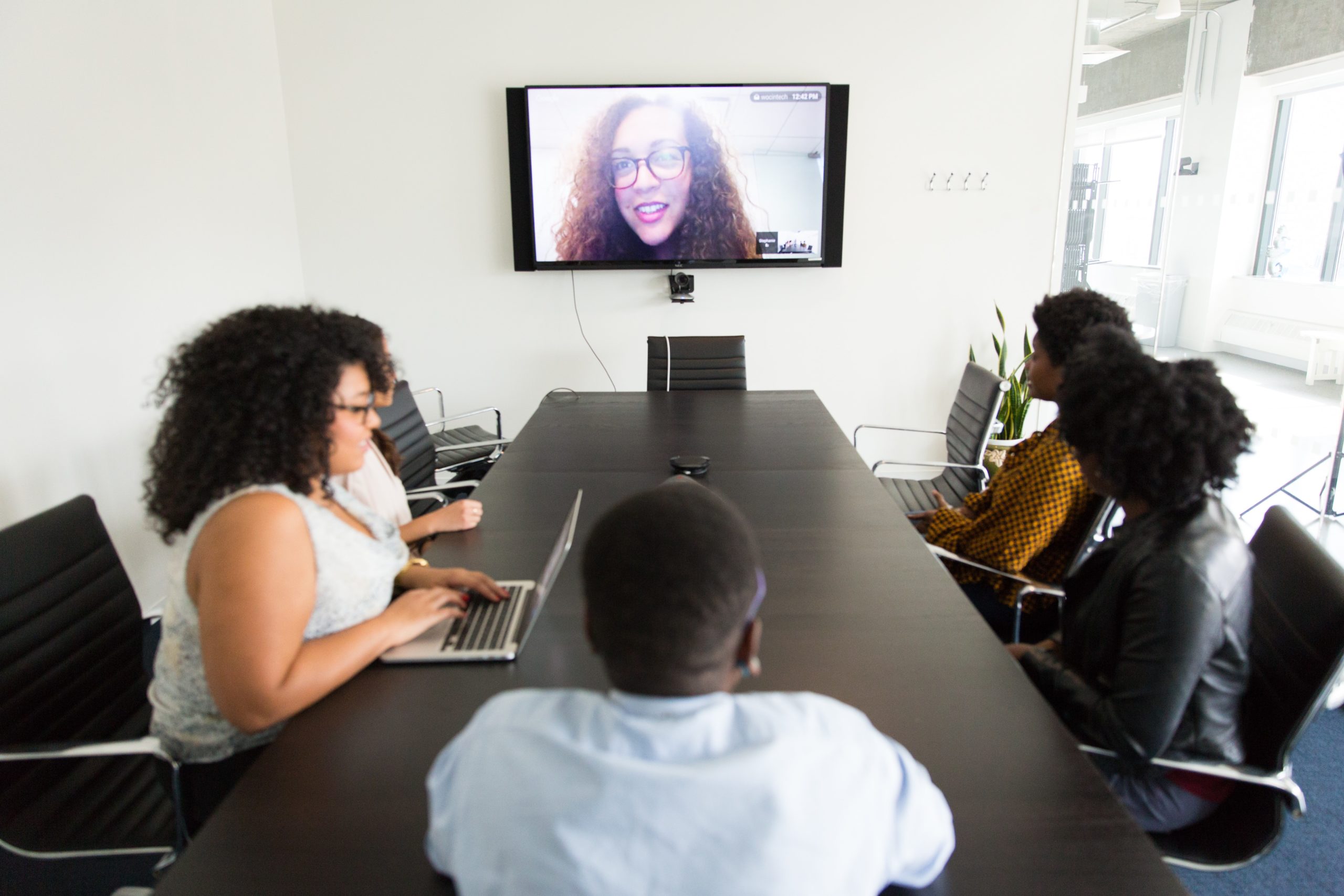The High Costs of Lost Human Connection
Uhh… I think you’re on mute.

Do you even remember saying that before March 2020?
Realistically, most of us only had 1 or 2 virtual meetings per week before COVID, but now we’re spending over 2.7 billion minutes in online meetings every single day.
…but, this begs the question – are we really “meeting”?
Ok, technically, we’re all logged in to the same discussion, but most of us aren’t even paying attention (The latest research from Business Wire found that 85% of employees are multitasking during online meetings – 77% are checking email, 74% are doing other work, and 30% are scrolling through social media).
Can you imagine a face to face meeting where 8 out of 10 people are completely distracted? We’d never get anything done!
So, should we put all of our efforts into helping our employees focus on online meetings? Nope. Distraction isn’t even our biggest issue.
Have our encounters become too transactional?
Picture this: We’re spending 5x more time in meetings than we did pre-pandemic (22% of us are even spending over half of our week in virtual meetings). We’ve become so busy, rushed, and overwhelmed that we just don’t have any spare time anymore, let alone time for the personal touches that made our work feel a little less like work –
Things like grabbing a coffee together on our walk to the conference room, the handshakes, hugs, and small talk, and the conversations as we’re walking back to our desks – All of this has been mostly replaced with a quick wave and click of the red button at the end of our meeting.
What’s really keeping your people from doing their best work?
At Enboarder, we knew that distraction and overwhelm were certainly issues, but we had a feeling that these were just symptoms of a larger underlying problem that’s hurting employee motivation and morale.
On the hunt for the true root cause, we interviewed thousands of employees to understand how they’re feeling, what they’re struggling with, and what’s really going on in our new remote and hybrid work environments. (You can get the full report here.)
Spoiler alert: The biggest problem is a lack of Connection.
The 4 elements of the Enboarder Engagement Model
Our research showed that 4 elements need to be actively present at the same time in order to drive meaningful action:
- Engagement – Personalized and meaningful messaging that motivates the employee to take action..
- Nudges – Timely, relevant, and actionable reminders.
- Ease – A low-friction experience where it’s easy to accomplish the task at-hand
- …and a feeling of Connection
(Read more about the model here.)
The first three elements are typically easier for organizations to understand…
…but connection can be more abstract and much harder to implement – especially when the majority of your workforce is remote or hybrid.
…But why does connection matter?

Connection is more than just an HR buzzword; It’s the single biggest factor influencing if and how our people are motivated to do their best work.
It’s just a fact.
The results of our research show, a full 82% of employees say they’re more motivated to work on a project/program (and 84% of employees find it easier to do their best work) when they feel close to their team.
And it’s not just project work that’s influenced by interpersonal connection – 71% of employees agreed that, to learn something new or change their thinking (success criteria for an HR program), they need to discuss it with someone.
…but who can our people discuss things with if they’re constantly bouncing between virtual meetings all day?
Today, our people are feeling actively DISCONNECTED.
More than two-thirds of the employees we surveyed (67%) agreed it’s very difficult to create and maintain meaningful connections with coworkers virtually, and more than half (55%) said it’s not as easy to make friends at work remotely as it is in the office.
In all, 69% of respondents don’t feel very connected to their coworkers today.
If our people are feeling so disconnected, how can they do their best work?
Statistically, they can’t.

…and this will only be compounded by The Great Resignation.
We saw a record in August 2020, with 4.3 Million Americans leaving their jobs (…more than in any other month in recorded history).
This means millions of people will be starting fresh at new companies, and, while many of us had time to form relationships with our co-workers in the office before we went remote in early 2020, this can’t be said for our new hires who are being thrown into hybrid or remote work environments – sometimes without ever meeting any members of their team in person.
Maintaining relationships in a virtual world is difficult. Forming brand new relationships with people you’ve never actually met is much harder.
So, how can we help our people feel connected in our new remote and hybrid world?

Ok, now we’ve seen how connection is necessary for our people to really engage and thrive, and how it’s the pivotal component of the Human Connection Model that needs to be in place for employee action to occur.
Here are 4 areas where you can fix connection in your HR programs and start seeing results today:
How can you help your new hire to feel connected from day 1 (So they’ll stay for day 2)?
- Involve the whole team! Send your team reminders to introduce themselves and welcome their new hire to the company.
- If you don’t already have them in place, set up a buddy system, and regularly remind buddies or managers to ensure they’re keeping up with their new hires to improve connection and morale.
A dash of human connection will keep your new hires feeling engaged and like they’re part of the team.
Encourage your overwhelmed employees to participate together in the L&D programs they desperately need to stay on top of the market by:
- Setting up learning mentor/mentee programs or buddy systems, and sending reminders to mentors/buddies to encourage and challenge each other to achieve their Learning goals.
- Creating and encourage peer-to-peer learning opportunities instead of all learning being pushed “top-down”
- Fostering a ‘Culture of Learning’ in your workplace, where Learning and Development is looked up to, celebrated, and rewarded.
Remember, almost 3/4 of employees felt they needed to discuss new ideas or concepts with their peers in order to learn something new or change their thinking.
Help give them that opportunity.
Help your employees really feel like they’re part of a team and not going through organizational changes on their own through:
- Facilitating moments of connection for your remote and in-office people to avoid them growing apart.
- Setting up return-to-work buddies for hybrid employees to help make the trek back to the office less stressful.
- Communicating a strong sense of connection as your two teams become one during a Merger or Acquisition process.
- Ensuring all departments working on executing the change are able to collaborate and communicate effectively.
Deep down there’s comfort in knowing that we’re all going through a change together. Make sure your people feel supported and help keep their minds at ease.
Regardless of the specific move, an internal move almost always means a new team.
With feelings of fear, uncertainty, and loneliness especially common during times of change, a strong sense of connection can help turn them into feelings of ambition, confidence, and comradery!
Try:
- Encouraging members of your team to reach out and welcome their new peer and invite them to lunches or other appropriate events.
- Setting up mentor/mentee programs or buddy systems, and reminding mentors regularly to ensure they’re keeping up with their mentee or buddy to improve connection and morale.
- Facilitating relaxed moments of connection between first-time managers and their direct reports.
Internal moves can greatly affect the relationships between peers as they move into new areas of the business. Ensure a smooth transition by encouraging connection between your employees as they move into new positions.
…One last thing.
If implemented correctly, the strategies above will help your people feel more connected at the key moments when they need you most.
…but all those tips will just come off as “tactics”, and your employees won’t engage, if they don’t feel a genuine sense of compassion in them.
So, how do we convey true compassion?
By keeping your employees in mind throughout the process and implementing things from their perspective.
So put yourself in your people’s shoes by asking yourself questions like these:
- What do your people’s workloads and schedules look like?
- What messages are they currently receiving and at what frequency?
- What do their typical messages, notifications and requests look like?
- How many different systems and logins do your people currently have to use and remember?
- What tasks or actions are keeping your people from forming meaningful relationships, and what could you do to help them?
Remember, your employees want to engage with your programs and feel deeper connections with their co-workers, the current work environment is just making it difficult for them. Show them that you’re working to see things from their perspective with thoughtful and helpful messaging and strategies and every aspect of their work quality and motivation will improve!
For the rest of the findings from our full research report – Click here.
Want to see results faster?
We got you.
We built our whole platform around this very psychology and the four elements of the Enboarder Engagement Model to allow you to build and deploy effective human-centric journeys from day one.
Whether it’s onboarding, learning and development, change management, diversity and inclusion, or employee transitions, we’ve reimagined HR.
Get a free demo today and find out why our customers love Enboarder as much as you’re about to!